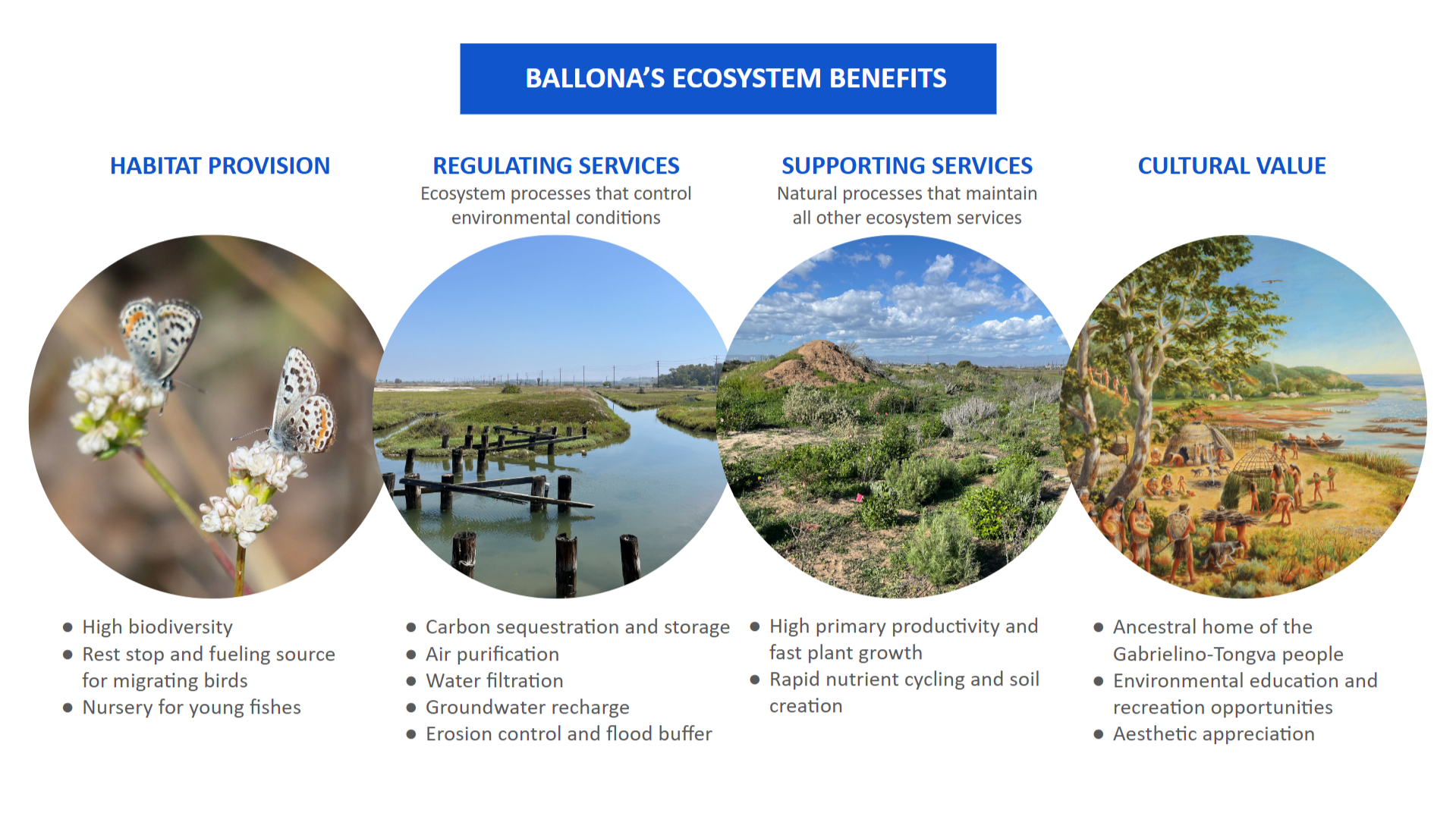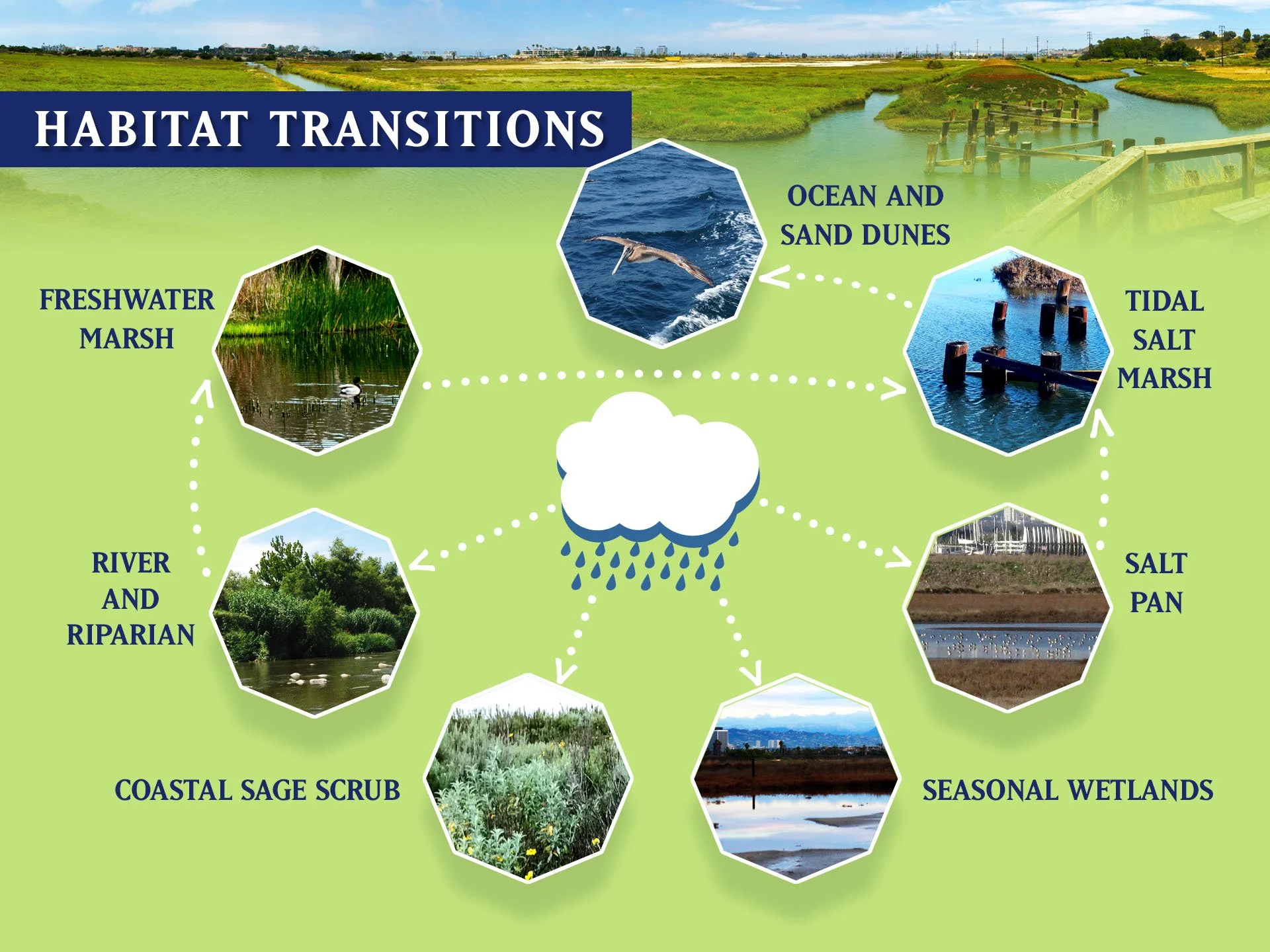The Ballona Climate Connection
The Ballona Climate Connection
By California Climate Action Corps Fellow Mina Bedogne
Wetlands are highly productive, biologically diverse ecosystems where water covers the soil for at least part of the year. These global hubs of biodiversity provide immense benefits to humans and wildlife alike. Such positive impacts, also known as ecosystem services, range from water filtration and flood control to recreational opportunities and aesthetic value.
Here at the Ballona Wetlands, we highlight the wetlands’ role in providing habitat for ecologically and culturally significant flora and fauna and supporting educational enrichment for Angelenos of all ages from across Los Angeles County and beyond. Notably, wetland ecosystems also play an immense role in mitigating, or reducing, the impacts of climate change.
From supporting a diverse array of plants and animals to capturing greenhouse gas emissions, the Ballona Wetlands provide innumerable benefits to humans and the environment.
Image Source: from left to right, 1) Patrick Tyrrell, 2) Mina Bedogne, 3) Mina Bedogne, 4) Mary Leighton Thompson
In recent years, scientists have recognized coastal habitats such as tidal wetlands as the most effective carbon-accumulating ecosystems due to their capacity to both quickly pull carbon from the atmosphere and keep it stored for long periods. Healthy wetlands sequester, or capture, significant quantities of atmospheric carbon dioxide, a primary greenhouse gas, storing this carbon in plants and soil and representing critical carbon sinks. These coastal reservoirs store more carbon dioxide than they release. This so-called “blue carbon” storage is essential to reducing the impact of human-caused greenhouse gas emissions and supporting a more stable climate.
CARBON SEQUESTRATION AND STORAGE
But why are these ecosystems so good at sequestering and storing carbon?
There are two main explanatory factors:
1) Wetlands experience high primary productivity, meaning they support accelerated plant growth.
2) Wet soils create anaerobic (oxygen-free) conditions that cause organic material to decompose very slowly.
As plants grow, they use carbon dioxide and sunlight to create chemical energy, converting atmospheric carbon into the organic carbon that makes up biomass. This process is known as photosynthesis. Once vegetation dies, it begins to decompose, with microorganisms breaking down both above-ground plant matter, such as leaves and stems, and below-ground roots. Through this process, carbon is incorporated into the soil.
Plants in coastal wetlands absorb carbon dioxide through photosynthesis, returning some carbon to the atmosphere as methane and carbon dioxide while incorporating the rest into oxygen-free soils that favor long-term carbon storage.
Image Source: Sarah Battle, NOAA Pacific Marine Environmental Laboratory
During decomposition, soil microbes naturally produce carbon dioxide, which eventually diffuses out of soil pores and into the air. In the case of wetlands, the low oxygen levels in saturated soils limit microbial activity, slowing decomposition and supporting long-term carbon storage. As such, wetlands can accumulate soil carbon at a much higher rate than other ecosystems.
Additionally, mineral sediments and organic matter regularly wash into low-lying wetland areas from other watershed sources, burying decaying plant matter. This process of rapid soil accretion, or creation, further supports carbon storage.
CARBON VARIABILITY
Of course, not all wetlands contribute to emissions reduction in the same way or to the same extent. Carbon accumulation rates and soil carbon content vary across sites due to local factors, including differences in temperature, sediment composition, plant communities, and tidal influence. Even within sites, climate mitigation potential can greatly differ. For example, the Ballona Wetlands Ecological Reserve encompasses not only intertidal marsh habitat but also sand dunes, coastal sage scrub, and seasonal wetlands. According to a study by Dr. Todd Bear examining Ballona’s carbon sequestration potential, the wetlands’ tidally-influenced areas absorb carbon dioxide faster than drier high-elevation habitats such as sparsely vegetated uplands or dunes. However, these lower-elevation areas also represent the lowest soil organic carbon density because they have not experienced as much soil accumulation, highlighting the need to acknowledge nuances when exploring Ballona’s overall climate impact.
Ballona encompasses a variety of habitats and plant communities that extend beyond its tidal marsh.
Image Source: Friends of Ballona Wetlands
Another key difference is between saltwater and freshwater wetlands. While low-oxygen soils effectively limit carbon dioxide emissions, the microbes that thrive in these conditions are known to produce methane, a greenhouse gas that traps significantly more heat per molecule than carbon dioxide in the short term. However, saltwater contains sulfate, a naturally occurring compound used by microbes that outcompete methane-producing bacteria. Consequently, saltwater marshes emit significantly less methane than freshwater marshes, which have a lower sulfate content. In either case, these natural methane emissions have long been part of the Earth’s life-stabilizing carbon cycle, while recent human activities have doubled the concentration of methane in the atmosphere compared to pre-industrial levels.
WETLANDS LOSS AND DESTRUCTION
Healthy, intact wetlands continuously sequester carbon and provide stable sinks, with some of the oldest storing hundreds or even thousands of years' worth of accumulated carbon. Despite this immense climate benefit, wetlands are among the most threatened ecosystems globally. In the United States, wetlands continue to disappear at an increasing rate due to direct human activity and climate change impacts such as sea level rise. This trend is especially true for saltwater and vegetated marshes, resulting in a loss of stored carbon, a diminished ability to store more, and unnaturally high methane emissions.
Across California, few of the State’s historic wetlands remain due to urban development, agricultural expansion, and other anthropogenic pressures, resulting in immense reductions in habitat area and carbon sinks. Here in Los Angeles County, Ballona represents less than five percent of the County’s original marsh area and its last remaining major coastal wetland.
The construction of neighboring Marina del Rey impaired the health of the Ballona wetlands.
Image source: Marina del Rey Historical Society
Before the Industrial Revolution, the Ballona Wetlands encompassed 2,000 acres of heterogeneous habitat that stretched from present-day Playa del Rey to Baldwin Hills. During the last century, Ballona incurred a range of misuses, including the installment of the famous Los Angeles Motordrome and the Pacific Electric Red Car transit system in the early 20th century, the concrete channelization of Ballona Creek in the 1930s and 40s, and the dumping of 3.5 million cubic yards of dredged fill from the construction of neighboring Marina del Rey in the 60s. Such changes greatly affected Ballona, converting diverse native habitats into degraded uplands, releasing stored carbon, and limiting the ability to capture greenhouse gas emissions.
RESTORING BALLONA’S MITIGATION POTENTIAL
Despite a legacy of abuse, hope for reviving the Ballona Wetlands has been at an all-time high. Since 1978, Friends of Ballona Wetlands has protected the wetlands against further development pressures through advocacy, ecological restoration, and environmental education. Thanks to the Friends’ patient and methodical community efforts, the State purchased Ballona’s remaining 600 acres in 2003 and designated it an Ecological Reserve in 2005. Around this time, government stakeholders also installed a new tide gate between Ballona Creek and the Reserve, enhancing the connection to the sea and increasing the cover of saltmarsh habitat .
In addition to new infrastructure, hands-on restoration efforts by a dynamic mix of dedicated staff, interns, volunteers, students, and community partners have been critical to restoring healthy native habitats and increasing carbon sequestration. Even in its current state, the wetlands continue to accumulate organic carbon. Removing non-native invasive vegetation and increasing the cover of native flora helps return soils to a healthier state, allowing the storage of even more carbon while supporting wildlife and enhancing other ecosystem services. In the future, replacing concrete channels with earthen barriers and non-linear natural flows could further increase tidal influence, significantly amplifying the wetlands' climate mitigation potential, revitalizing terrestrial and aquatic habitats, and improving water filtration capabilities.
In the meantime, supporting Ballona Wetlands at community events is as important as ever. Whether rolling up your sleeves to pull out invasive species or attending a docent-led tour to learn more about this unique ecosystem, every action counts! To join, see our calendar of events: https://www.ballonafriends.org/community-events. You can also lend a hand to other local wetlands, including Madrona Marsh in Torrance, Los Cerritos Wetlands in Seal Beach, and the Bolsa Chica Wetlands in Huntington Beach.
Definitions
Wetland - an area where water covers the soil for at least part of the year (this hydrology defines its unique soil, flora, and fauna)
Ecosystem services - the benefits that ecosystems provide to people
Regulating services - ecosystem processes that control environmental conditions (e.g., water filtration and air purification)
Supporting services - natural phenomena that maintain fundamental ecosystem processes (e.g., nutrient recycling and primary productivity)
Greenhouse gases - heat-capturing atmospheric gases (carbon dioxide and methane are the two most abundant)
Climate change mitigation - actions that reduce greenhouse gas emissions, minimizing climate change impacts
Carbon sequestration - the process of capturing greenhouse gases from the atmosphere
Carbon storage - the incorporation and retention of atmospheric carbon
Carbon sink - a natural or artificial reservoir that absorbs more greenhouse gas emissions than it releases
Blue carbon - carbon captured by and stored in the ocean and coastal ecosystems
Photosynthesis - the process by which plants use sunlight, water, and carbon dioxide to make oxygen and organic compounds
Primary productivity - the rate at which plants and other autotrophs convert sunlight into organic compounds through photosynthesis
Anaerobic - occurring without oxygen (low oxygen levels slow down decomposition)
Decomposition - the breakdown of organic substances into simpler compounds (slower decomposition results in a slower release of carbon into the atmosphere)
Soil accretion - an increase in soil elevation from the accumulation of sediment and organic matter
Carbon accumulation rate - the rate at which carbon is stored in soil
Soil carbon content - the amount of inorganic and organic carbon stored in an area of soil
Methane - a potent greenhouse gas
Citations
Bear, T. M. (2017). Soil Carbon Sequestration and Carbon Market Potential of a Southern California Tidal Salt Marsh Proposed for Restoration [PhD dissertation, University of California, Los Angeles (UCLA)]. https://escholarship.org/uc/item/1x80s86s
Cal. Code Regs. Tit. 14, § 630 - Additional Visitor Use Regulations on Department Lands Designated as Ecological Reserves. (n.d.). LII / Legal Information Institute. https://www.law.cornell.edu/regulations/california/14-CCR-630
California Department of Fish and Wildlife [CDFW]. (n.d.). Ballona Wetlands Restoration Project. https://wildlife.ca.gov/Regions/5/Ballona-EIR
California Natural Resources Agency [CNRA]. (2022). California’s Natural and Working Lands Climate Smart Strategy. https://resources.ca.gov/initiatives/expanding-nature-based-solutions
Dan, L., & Grimsditch, G. (2009). The Management of Natural Coastal Carbon Sinks. https://iucn.org/resources/publication/management-natural-coastal-carbon-sinks
Friends of Ballona Wetlands. (n.d.-a). History of Ballona Wetlands. https://www.ballonafriends.org/history-of-ballona-wetlands
Friends of Ballona Wetlands. (n.d.-b). Restoring Ballona. https://www.ballonafriends.org/restoring-ballona
NASA. (2025, January). Methane | Vital Signs – Climate change: Vital signs of the planet. https://climate.nasa.gov/vital-signs/methane/?intent=121
National Oceanic and Atmospheric Administration [NOAA]. (2024, June 25). Coastal Blue Carbon. National Ocean Service. https://oceanservice.noaa.gov/ecosystems/coastal-blue-carbon/
United States Army Corps of Engineers, Los Angeles District [USACE] & California Department of Fish and Wildlife, South Coast Region [CDFW Region 5]. (2017). Ballona Wetlands Restoration Project Draft Environmental Impact Report (DEIR). https://nrm.dfg.ca.gov/FileHandler.ashx?DocumentID=149710&inline
U.S. Fish and Wildlife Service [USFWS]. (2024, March 22). 2019 Wetlands Status and Trends Report. https://www.fws.gov/project/2019-wetlands-status-and-trends-report
Washington State Department of Ecology. (2023, May 9). American Wetlands Month: Spotlighting the significant role wetlands play in climate change. https://ecology.wa.gov/blog/may-2023/american-wetlands-month-spotlighting-the-significa
Wetlands International. (2024). Wetlands and Methane. https://www.wetlands.org/publication/wetlands-and-methane-technical-report/





